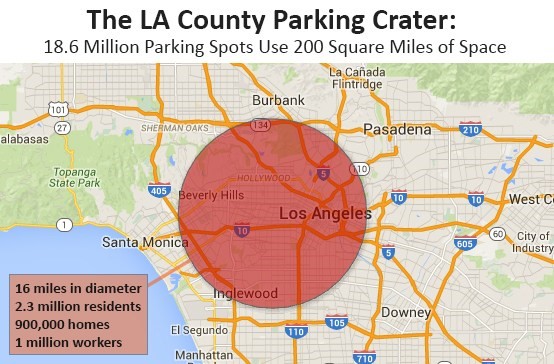Many communities across the U.S. are struggling with high housing costs and looking for ways to increase local housing supply. What if there was a way to create more land for building homes and lower the cost of construction?
Some municipalities are doing exactly that. How? Parking reform. Less space to house cars, more space to house people. Local zoning codes commonly contain parking minimums, or the minimum required number of parking spaces a project must include based on anticipated parking demands. As a result, parking in cities and towns around the country consumes a vast amount of space – and a lot of money, too.
Donald Shoup, research professor of urban planning at UCLA, leading expert on parking policy and author of books such as The High Cost of Free Parking (2005) and Parking and the City (2018) estimates that there are as many as two billion parking spots in the United States for a scant 200 million cars.
For example, what Los Angeles County’s 18.6 million parking spaces would look like as one enormous blob.
Shane Phillips at Better Institutions created the L.A. County image, commenting:
No one’s arguing that all 18.6 million parking spaces in Los Angeles are a waste; there’s an obvious need for parking, and for the automobiles that require them, in a variety of circumstances. But put together, this 200 square mile area is home to about 2.3 million people, 900,000 homes, and near one million employees. And without so much parking it could be home to many more, at a time when our region is struggling with an unprecedented housing shortage, booming population, and a strong economy.
The High Cost of Parking—and the Impact on Housing
Parking mandates are absorbed into total project costs, often raising the cost of development, with costs often passed on to the consumer. A surface parking space can cost an additional $5,000-$10,000, while garage parking can cost $25,000 to $50,000 per space. A national study in 2017 found that garage parking increased an average apartment’s rent by about 17 percent.
Parking minimums can also determine whether a project gets built at all. An analysis from Sightline Institute found that without off-street parking requirements in the inner neighborhoods of Portland, Oregon, the case study site would be most profitable housing 32 mixed-income condominiums – 28 market-rate units at $280,000 each, plus four affordable units at below-market rates. Yet, following parking mandates on this proposed site, the reality is much more costly because of the cost of car storage: a builder would be able to deliver only 10 townhomes profitably, valued at $733,000, each, with an on-site garage.
Transportation Trends: Moving Faster than a Parked Car
Zoning codes can take decades to update, while shifting transportation trends and technology improvements reflect transformations in parking demand much more rapidly.
The idea of a monthly mobility package as envisioned by “City of the Future” imagines how one could bundle together transit, bike-share, car-share and ride services to be significantly cheaper—and more convenient than owning a car. The potential: a valuable alternative to car dependency, with incentives to right-size parking availability, improve mobility and expand housing affordability.
Where to Start?
To achieve these benefits, an increasing number of localities are updating zoning codes to eliminate parking mandates for new projects – and instead let the market decide what the optimum parking is for the project. To help track these changes, Strong Towns has created a crowdsourced Google map featuring cities that have lowered or eliminated minimum parking requirements.
A few of the places that have updated their parking mandates in the last two years:
- Buffalo, New York became the first U.S. city to completely remove minimum parking requirements citywide in early 2017, applicable to developments of less than 5,000 square feet.
- Hartford, Connecticut eliminated parking minimums citywide for all residential developments.
- In 2018, the Seattle city council adopted parking regulation reforms that eliminated parking minimums in some areas to support sustainability and climate action goals.
- Denver’s recent residential zoning revisions do not require off-street parking for single-family homes.
- San Francisco has eliminated the city’s minimum parking requirements, which were adding between $20,000-50,000 to the cost of an apartment in the city.
- Minneapolis cut its multifamily parking requirements in some neighborhoods in half for larger apartment projects and eliminated parking mandates entirely for projects with 50 or fewer units located near high-frequency transit. The impact: lowered the cost of construction and lowered rents.
Parking for the Future
With an urgent need for more housing options in many communities, pressure for climate action to reduce greenhouse gas emissions and a growth in transportation alternatives that can reduce the need for car ownership, it is only plausible that localities would re-examine parking mandates for new construction.
Commercial real estate advisory firm Green Street Advisors has even estimated that U.S. parking needs could decline by 50 percent or more in the next 30 years.
Given these transformative projections, rededicating land that once would have required builders to pave over with asphalt for parking to more productive uses – such as housing people – is a good indicator of what’s in store for the 2020s.
Deborah Myerson is Principal of Myerson Planning & Development Consulting and Executive Director at South Central Indiana Housing Opportunities (SCIHO) in Bloomington, Indiana.


